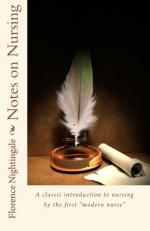It is not, however, either death or delirium of which, in these cases, there is most danger to the patient. Unperceived consequences are far more likely to ensue. You will have impunity—the poor patient will not. That is, the patient will suffer, although neither he nor the inflictor of the injury will attribute it to its real cause. It will not be directly traceable, except by a very careful observant nurse. The patient will often not even mention what has done him most harm.
[4] [Sidenote: The sick would rather be told a thing than have it read to them.]
Sick children, if not too shy to speak, will always express this wish. They invariably prefer a story to be told to them, rather than read to them.
V. VARIETY.
[Sidenote: Variety a means of recovery.]
To any but an old nurse, or an old patient, the degree would be quite inconceivable to which the nerves of the sick suffer from seeing the same walls, the same ceiling, the same surroundings during a long confinement to one or two rooms.
The superior cheerfulness of persons suffering severe paroxysms of pain over that of persons suffering from nervous debility has often been remarked upon, and attributed to the enjoyment of the former of their intervals of respite. I incline to think that the majority of cheerful cases is to be found among those patients who are not confined to one room, whatever their suffering, and that the majority of depressed cases will be seen among those subjected to a long monotony of objects about them.
The nervous frame really suffers as much from this as the digestive organs from long monotony of diet, as e.g. the soldier from his twenty-one years’ “boiled beef.”
[Sidenote: Colour and form means of recovery.]
The effect in sickness of beautiful objects, of variety of objects, and especially of brilliancy of colour is hardly at all appreciated.
Such cravings are usually called the “fancies” of patients. And often doubtless patients have “fancies,” as e.g. when they desire two contradictions. But much more often, their (so called) “fancies” are the most valuable indications of what is necessary for their recovery. And it would be well if nurses would watch these (so called) “fancies” closely.
I have seen, in fevers (and felt, when I was a fever patient myself), the most acute suffering produced from the patient (in a hut) not being able to see out of window, and the knots in the wood being the only view. I shall never forget the rapture of fever patients over a bunch of bright-coloured flowers. I remember (in my own case) a nosegay of wild flowers being sent me, and from that moment recovery becoming more rapid.
[Sidenote: This is no fancy.]
People say the effect is only on the mind. It is no such thing. The effect is on the body, too. Little as we know about the way in which we are affected by form, by colour, and light, we do know this, that they have an actual physical effect.




